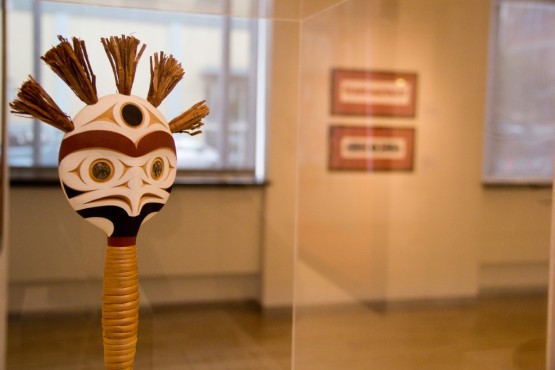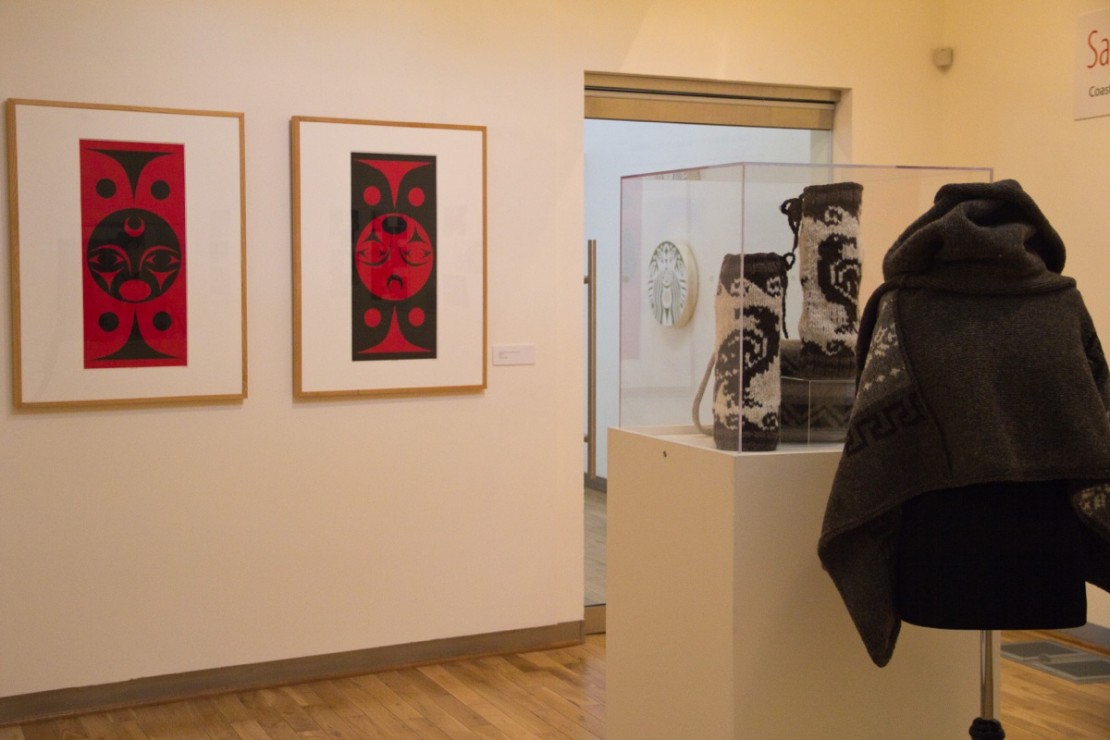
Nikki Koutsochilis (photo)
Entering Perpetual Salish at the Legacy Art Gallery, one is introduced to a new artistic landscape. The show features pieces from five contemporary Indigenous artists, who all originate from Central Coast Salish territory, an area now known as Vancouver Island and the lower mainland of British Columbia. Although the Coast Salish territory extends to where many potential gallery visitors are currently living, Coast Salish art is still relatively unknown compared to other Northwest Coast arts.
This bias began with classic introductory Indigenous art texts, such as Bill Holm’s “Northwest Coast Indian Art“ (1965), which do not feature Coast Salish artists. Perpetual Salish provides a basic knowledge of Salish aesthetics and history through the documentary created by Legacy staff and visually inspecting the art. For example, a key element in new and old works is the use of three geometric elements: the circle, crescent, and trigon (a triangle with curved sides).
Perpetual Salish is refreshing as it depicts basic knowledge, such as Coast Salish aesthetics, but also disrupts these notions. With Indigenous art, audiences increasingly want to see “authentic” art, which many only associate with traditional works. lessLie, a Cowichan curator and artist of Perpetual Salish, explains in the curator panel that the exhibit demonstrates the continuation of Coast Salish art and ideas, but also how many contemporary works “go beyond tradition” by “incorporating North American visual culture into Coast Salish art.” He illustrates that each artist has a different interpretation of this modern Salish style, which becomes clear as you arrive inside the gallery, struck by the juxtaposition between Susan Point’s “Salish Vision” (2002) and lessLIE’s “Cultural CununDRUM” (2013).
Point, often recognized as inaugurating contemporary Coast Salish art, presents one of the more traditional pieces in the exhibit with Salish Vision due to its subject matter and material. Carved out of red cedar, it features interconnecting animal figures. Displayed in the lower centre is a frog, whose back legs are composed of salmon heads, while the frog’s front legs are feathers from a pair of Thunderbirds. By joining these three animals, Point is demonstrating the balance between the land (frog), sea (salmon), and sky (Thunderbird) which Coast Salish need to maintain.
Meanwhile, lessLIE’s “Cultural CununDRUM,” an acrylic painting on top of a hide drum, does use traditional features and mediums, but adopts them to contemporary ideas. For example, the main figure of this piece is a merman closely resembling the Starbucks logo, but with some significant changes. Instead of a tail and crown, lessLIE uses salmon heads to stress the importance of this fish in Coast Salish life. By using a popular western business emblem, lessLIE fosters ideas of copyright, wealth, and land, concepts which the Coast Salish must fight for on a daily basis. The artist also demonstrates that Coast Salish art is not static, but has instead created a cross-cultural dialogue. The correlation between these two pieces in the entrance of the gallery represents the continuum of Coast Salish art.
A common symbol in the show is the iconography of a spindle whorl, a round wooden device with a centre hole which a weaver would use to spin wool. However, the spindle whorls are more than practical to the Coast Salish; they are also spiritual. Traditionally the whorls are decorated on the convex side, with a pattern to represent the spinner’s spirit helper. The spirit guide may emerge when the spinner is working in a trance-like state due to the pulsating movement of the decorated spindle whorl. Even Point’s “The Circle Within” (2007), a square piece with no hole, alludes to this traditional weaving tool.
“The Circle Within” contains eight square patinated bronze panels surrounding a painted cedar panel. Each panel features a school of overlapping salmon encircling a convex circle. The central cedar panel evokes a spindle whorl as the convex circle features the same swirling motion. It is interesting that Point uses bronze in this work, as it could refer to mining and colonizers taking resources from the land. By combining bronze and wood, Point could also be alluding to the idea of high and low material art in Western culture. By referencing the spindle whorl and highlighting the cedar, Point indicates the perseverance of the Coast Salish people as they have held onto their spirituality despite the colonial obstacles which forced them to give up their culture.
The gallery had an ingrained route along the wall for visitors to contemplate the diversity of contemporary Coast Salish art. However, some of the more traditional pieces, such as John Marston’s “Spirit of the Forest: Mother Nature” (2013), are often unseen due to misplacement. Marston’s large face mask hangs parallel to the entrance, high above all the other pieces. Though this choice was to keep the work safe from being touched, it was hard to see the details of carved cedar or hand-made rope outline unless acquiring a catalogue. Likewise, Marston’s “Bentwood Box” (2011), a modern take on the traditional box with a slanted top, deeply carved figures, and a lack of paint, is also easily missed as it is the only piece not against the wall. Viewers must break their route by travelling to the middle of the room and then encircling the box to not only glimpse at the eagle but also the black painted wolf, complete with operculum to make up its realistic-looking teeth.
Perpetual Salish allows artist’s visual and personal voices to be heard, which reflect a refreshing change in modern-day curation. The exhibition is also invigorating for displaying innovative, cross-cultural work alongside a continuation of tradition with a modern twist. By weaving traditional and contemporary iconography, Perpetual Salish provides a new appreciation for Coast Salish art to its audience.
Perpetual Salish runs until Jan. 10 at the Legacy Art Gallery on 630 Yates St. For more information, visit uvac.uvic.ca.

Nikki Koutsochilis (photo)








